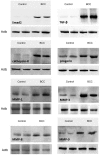Proteins involved in cutaneous basal cell carcinoma development
- PMID: 30128029
- PMCID: PMC6096141
- DOI: 10.3892/ol.2018.9126
Proteins involved in cutaneous basal cell carcinoma development
Abstract
Basal cell carcinoma (BCC) is the most common skin malignancy type in the Caucasian population, with a continuously increasing incidence rate. The etiology of BCC remains unknown, but it appears to have a multifactorial origin resulting from intrinsic and extrinsic factors, including short-wavelength ultraviolet B radiation. The role of specific proteins in BCC that are known to be responsible for the regulation of cell division and are involved in skin aging, including transforming growth factor (TGF)-β, Smad2, matrix metalloproteinases (MMPs)-1, -3, -8 and -9, cathepsin-K and progerin, remains unknown. The aim of the present study was to assess the mRNA and protein expression profile of samples with diagnosed nodular BCC (nBCC) compared with that of healthy skin samples collected from matched areas. The study group included 22 patients (10 men and 12 women; mean age, 59 years; range, 44-82 years) with pathologically confirmed nBCC, and 22 healthy volunteers (10 men and 12 women; mean age, 59 years; range, 43-78 years) as a control group. The expression of the studied proteins was assessed in all samples by western blotting and reverse transcription-quantitative polymerase chain reaction analysis. Statistically significant increases in the expression of TGF-β, Smad2, cathepsin-K, progerin and MMP-1, -3, -8 and -9 were detected in skin biopsies with diagnosed nBCC compared with the control group, confirming the important role of these proteins in skin carcinogenesis.
Keywords: biomedical recurrence; gene expression; model; prognosis; prostate cancer.
Figures





Similar articles
-
Impact of Ultraviolet Radiation on Expression of Transforming Growth Factor β, Smad2, Metalloproteinases-1, -3, -8, -9, Cathepsin K and Progerin.Photochem Photobiol. 2018 Mar;94(2):362-369. doi: 10.1111/php.12866. Epub 2018 Jan 19. Photochem Photobiol. 2018. PMID: 29164629
-
One week's holiday sun exposure induces expression of photoaging biomarkers.Folia Histochem Cytobiol. 2016;54(1):42-8. doi: 10.5603/FHC.a2016.0001. Epub 2016 Apr 5. Folia Histochem Cytobiol. 2016. PMID: 27044588
-
Increased expression of TGF-beta/Smad proteins in basal cell carcinoma.Eur J Med Res. 2007 Oct 30;12(10):509-14. Eur J Med Res. 2007. PMID: 18024258
-
Aggressive basal cell carcinoma: presentation, pathogenesis, and management.Cancer Metastasis Rev. 2004 Aug-Dec;23(3-4):389-402. doi: 10.1023/B:CANC.0000031775.04618.30. Cancer Metastasis Rev. 2004. PMID: 15197337 Review.
-
Role of Matrix Metalloproteinases in Photoaging and Photocarcinogenesis.Int J Mol Sci. 2016 Jun 2;17(6):868. doi: 10.3390/ijms17060868. Int J Mol Sci. 2016. PMID: 27271600 Free PMC article. Review.
Cited by
-
The role of TGF-β and antimicrobial peptides in basal cell carcinoma: a systematic review.Postepy Dermatol Alergol. 2023 Jun;40(3):384-389. doi: 10.5114/ada.2023.124747. Epub 2023 Feb 1. Postepy Dermatol Alergol. 2023. PMID: 37545828 Free PMC article. Review.
-
Plasma concentrations of cathelicidin and β-defensins and their correlations in patients with basal cell carcinoma.Postepy Dermatol Alergol. 2022 Feb;39(1):226-227. doi: 10.5114/ada.2022.113809. Epub 2022 Feb 28. Postepy Dermatol Alergol. 2022. PMID: 35369619 Free PMC article. No abstract available.
-
More Than Skin Deep - the Effects of Ultraviolet Radiation on Cathepsin K and Progerin Expression in Cultured Dermal Fibroblasts.Clin Cosmet Investig Dermatol. 2021 Oct 27;14:1561-1568. doi: 10.2147/CCID.S318707. eCollection 2021. Clin Cosmet Investig Dermatol. 2021. PMID: 34737595 Free PMC article.
-
Cathepsin K in Pathological Conditions and New Therapeutic and Diagnostic Perspectives.Int J Mol Sci. 2022 Nov 9;23(22):13762. doi: 10.3390/ijms232213762. Int J Mol Sci. 2022. PMID: 36430239 Free PMC article. Review.
-
Unraveling the ECM-Immune Cell Crosstalk in Skin Diseases.Front Cell Dev Biol. 2019 May 7;7:68. doi: 10.3389/fcell.2019.00068. eCollection 2019. Front Cell Dev Biol. 2019. PMID: 31134198 Free PMC article. Review.
References
LinkOut - more resources
Full Text Sources
Other Literature Sources
